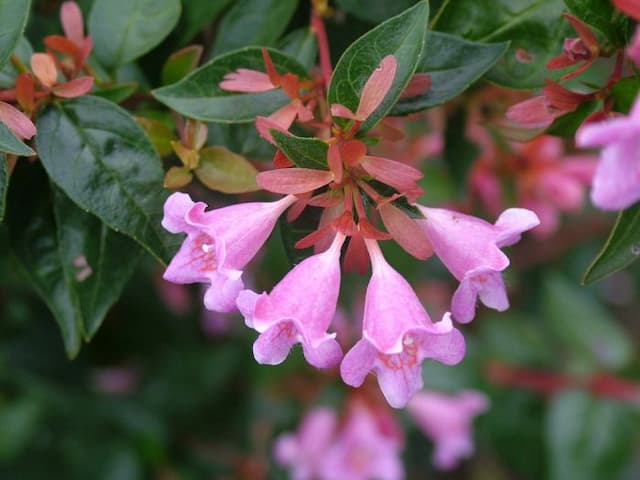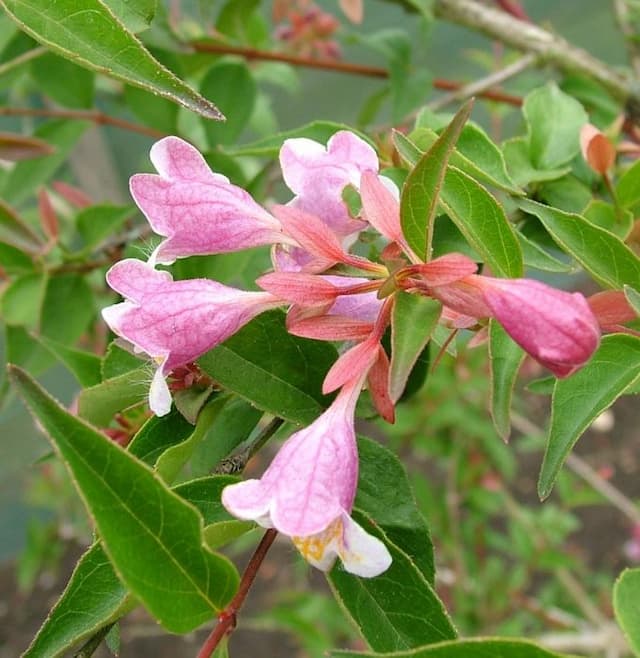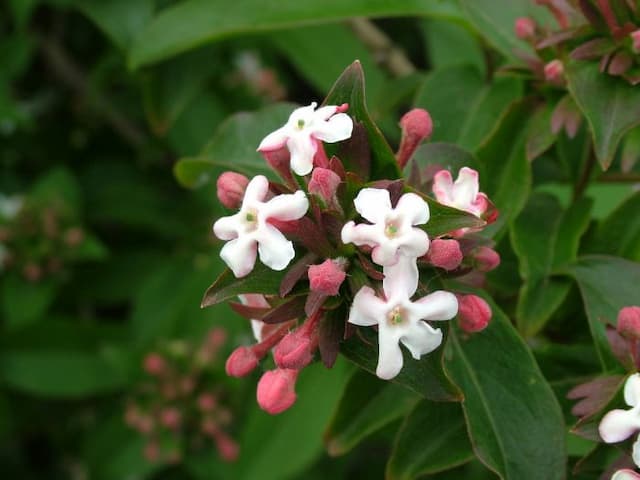Variegated Weigela Weigela 'Praecox Variegata' (v)

ABOUT
Weigela 'Praecox Variegata', commonly known simply as Weigela, is a deciduous shrub renowned for its striking foliage and beautiful blooms. The plant features ovate leaves that have a distinct variegated pattern, usually in shades of creamy white and green. This variegation adds a splash of brightness to the garden, contrasting nicely with the solid green leaves of nearby plants. The flowers of Weigela exhibit a tubular shape, perfect for attracting hummingbirds and other pollinators. They grow in clusters and boast a soft pink to rosy color, which can vary slightly in hue. These blossoms typically appear in spring, creating a vibrant display that adds to the decorative appeal of the shrub. One of the charms of Weigela 'Praecox Variegata' lies in its cascading branches, which tend to arch gracefully as the plant matures. This natural growth habit gives it an elegant and somewhat whimsical appearance that can complement various garden styles. Overall, Weigela 'Praecox Variegata' is appreciated by gardeners and landscapers for its combination of colorful foliage and eye-catching flowers, which work together to provide a long season of interest in the garden space.
About this plant
 Names
NamesSynonyms
Variegated Weigela, Variegated Early Weigela.
Common names
Weigela 'Praecox Variegata' (v).
 Toxicity
ToxicityTo humans
The Weigela is not generally considered toxic to humans. There are no well-documented cases of poisoning from Weigela in the scientific literature, and it is generally recognized as a safe plant when it comes to human interaction. However, as with any plant, individual allergies or sensitivities can occur, so it is advisable to exercise caution and avoid ingesting any part of the plant if you are unsure about your personal reaction to it.
To pets
The Weigela is not typically listed as a toxic plant to pets such as dogs and cats. This means that it is unlikely to cause any serious harm if pets consume small quantities of the plant. However, ingestion of large amounts of plant material may cause mild gastrointestinal upset in some animals due to the unusual nature of the material in their digestive system. It is always best to prevent pets from eating plants, as variability in individual sensitivity could lead to different reactions.
 Characteristics
CharacteristicsLife cycle
Perennials
Foliage type
Deciduous
Color of leaves
Variegated
Flower color
Pink
Height
4-6 feet (1.2-1.8 meters)
Spread
4-6 feet (1.2-1.8 meters)
Plant type
Shrub
Hardiness zones
4-8
Native area
Asia
Benefits
 General Benefits
General Benefits- Attracts Pollinators: Weigela 'Praecox Variegata' is known for its ability to attract bees, butterflies, and other pollinating insects, which can help support the health of your garden ecosystem.
- Decorative Foliage: The variegated leaves of this plant add a visual interest to gardens with their mix of green and creamy white colors.
- Showy Flowers: This weigela variety produces plentiful pink trumpet-like flowers in the spring, adding a burst of color to the landscape.
- Low Maintenance: Once established, this plant requires minimal care, making it a convenient choice for gardeners of all skill levels.
- Drought Tolerance: It has good drought tolerance once established, reducing the need for frequent watering.
- Hedge & Border Plant: It can be used effectively as hedging or as a border plant in landscaping designs due to its compact growth habit.
- Seasonal Interest: With a long blooming period and attractive foliage, it provides seasonal interest from spring through fall.
- Wildlife Habitat: The dense foliage can provide shelter for small wildlife, like birds, enhancing biodiversity in a garden setting.
- Hardiness: It is resistant to many pests and diseases, which allows it to thrive with fewer chemical treatments.
 Medical Properties
Medical PropertiesThis plant is not used for medical purposes.
 Air-purifying Qualities
Air-purifying QualitiesThis plant is not specifically known for air purifying qualities.
 Other Uses
Other Uses- Photography Prop: Weigela 'Praecox Variegata' with its attractive variegated foliage and pink blooms can serve as a picturesque backdrop or focal point in garden photography.
- Theme Gardens: This plant is ideal for creating a 'variegated' theme in a garden, where foliage and leaf patterns are the main feature rather than flower color.
- Garden Sculpture Framing: Weigela can be planted around garden sculptures to provide a soft, natural frame that enhances the art without overpowering it.
- Privacy Screening: With strategic planting, this dense shrub can provide privacy for ground-level patios or low windows.
- Seasonal Interest: The foliage offers a unique visual interest in fall when gardens typically have fewer flowering plants.
- Education: Can be used in botanic gardens and educational institutions to teach variegation in plants and horticultural practices like pruning and shaping.
- Sound Barrier: The dense growth can help muffle noise when planted along the edge of a property near a busy street.
- Nectar Source: While not the primary use, the flowers can be a food source for local pollinators, which can be observed for educational or leisure purposes.
- Winter Texture: Even when dormant and leafless, the structure of Weigela's branches gives texture to a winter garden landscape.
- Garden Art: Creative gardeners can train or prune Weigela into various shapes to create living garden art or topiaries.
Interesting Facts
 Feng Shui
Feng ShuiThe plant Weigela is not used in Feng Shui practice.
 Zodiac Sign Compitability
Zodiac Sign CompitabilityThe plant Weigela is not used in astrology practice.
 Plant Symbolism
Plant Symbolism- Rejuvenation and Renewal: Weigela blooms profusely in early summer and sometimes again in late summer, symbolizing the idea of rejuvenation and the possibility of second chances.
- Optimism and Cheer: With its bright and variegated foliage, Weigela is thought to bring positive energy and happiness to the surroundings, representing a cheerful disposition.
- Welcoming: Often used in gardens and near entryways, Weigela is seen as a symbol of hospitality and welcoming guests with open arms.
- Endurance: Weigela is a hardy plant that can withstand various conditions, symbolizing the ability to endure and persist through difficult times.
- Adaptability: Given that Weigela thrives in a variety of soil types and environmental conditions, it represents adaptability to life's circumstances.
 Water
WaterVariegated Weigela should be watered deeply once a week, providing about 1 inch of water which equates to roughly 0.6 gallons for each shrub. During the warmer summer months or in times of drought, you may need to increase the frequency to twice a week. Always check the soil moisture before watering; the soil should be moist but not soggy. Over-watering can lead to root rot, so ensure good drainage is in place. In the cooler seasons or during periods of rainfall, reduce watering accordingly to prevent over-saturating the soil.
 Light
LightVariegated Weigela thrives in full sun to partial shade, so ideally, it should be placed in a spot where it can receive at least 6 hours of sunlight per day. It can tolerate some shade, but flowering is best in full sun. Avoid deep shade as it can lead to reduced blooming and can affect the vibrancy of the foliage.
 Temperature
TemperatureVariegated Weigela is hardy and can tolerate a wide range of temperatures, thriving best in USDA hardiness zones 4 through 8. It can generally handle temperatures down to -30°F and high temperatures well into the 90°F range. Ideally, maintaining a range between 50°F and 75°F will promote healthy growth and abundant flowering.
 Pruning
PruningPruning Variegated Weigela is important to maintain its shape and to encourage vibrant blooms. The best time to prune is immediately after the flowering period ends, which is usually in late spring or early summer. Remove any dead or broken branches, and cut back about one-third of the oldest stems to ground level to stimulate new growth. Pruning every year or every other year will keep your Weigela healthy and looking its best.
 Cleaning
CleaningAs needed
 Soil
SoilVariegated Weigela thrives in well-draining soil with a pH between 5.5 and 7.5. A mix of loam, peat, and sand ensures adequate drainage. Compost or well-rotted manure will enrich the soil, enhancing plant health and flowering.
 Repotting
RepottingVariegated Weigela, typically planted in the ground, does not require frequent repotting. In container gardening, repot it every 2-3 years to replenish soil and encourage growth.
 Humidity & Misting
Humidity & MistingVariegated Weigela prefers average outdoor humidity levels and does not require specific humidity adjustments, making it adaptable to many environments without special care for humidity.
 Suitable locations
Suitable locationsIndoor
Provide bright light, minimal watering, and cool winter.
Outdoor
Plant in sun, amend soil, water regularly.
Hardiness zone
4-8 USDA
 Life cycle
Life cycleWeigela 'Praecox Variegata' (v), commonly known as Variegated Weigela, begins its life cycle with seed germination, typically in the spring, under appropriate conditions of warmth and moisture. The seedling stage follows, where the plant establishes its root system and begins to sprout leaves. In the vegetative stage, the plant undergoes significant growth, developing a woody structure, foliage, and branches. Variegated Weigela enters the blooming stage once mature, producing trumpet-shaped flowers in various colors, usually from late spring to early summer, attracting pollinators. After pollination, the plant develops fruits, which are capsule-like and contain seeds for the next generation. Finally, in the dormancy stage, which occurs during the colder months, the plant's growth slows down or stops to conserve energy, readying it for the next growth cycle in the following spring.
 Propogation
PropogationPropogation time
Spring-Early Summer
Weigela 'Praecox Variegata' is often propagated by softwood cuttings taken in late spring or early summer. To do this, select a healthy, non-flowering shoot and cut a 4 to 6 inch (10 to 15 cm) piece, making sure there are at least two or three sets of leaves. Dip the cut end in rooting hormone, then place it in a pot filled with a well-draining potting mix, such as a mix of peat and perlite. It's crucial to maintain a high humidity around the cutting, so covering the pot with a plastic bag or using a humidity dome can help. Place the setup in a warm spot with indirect sunlight until roots develop, which typically takes several weeks. After the cuttings have rooted, they can be acclimatized to less humid conditions and eventually transplanted outdoors.







![Himalayan honeysuckle [Golden Lanterns]](/_next/image?url=https%3A%2F%2Fplants-admin.emdemapps.com%2Fimages%2Fplants%2F%2Fimages%2F604b55302cc87.png&w=640&q=75)

